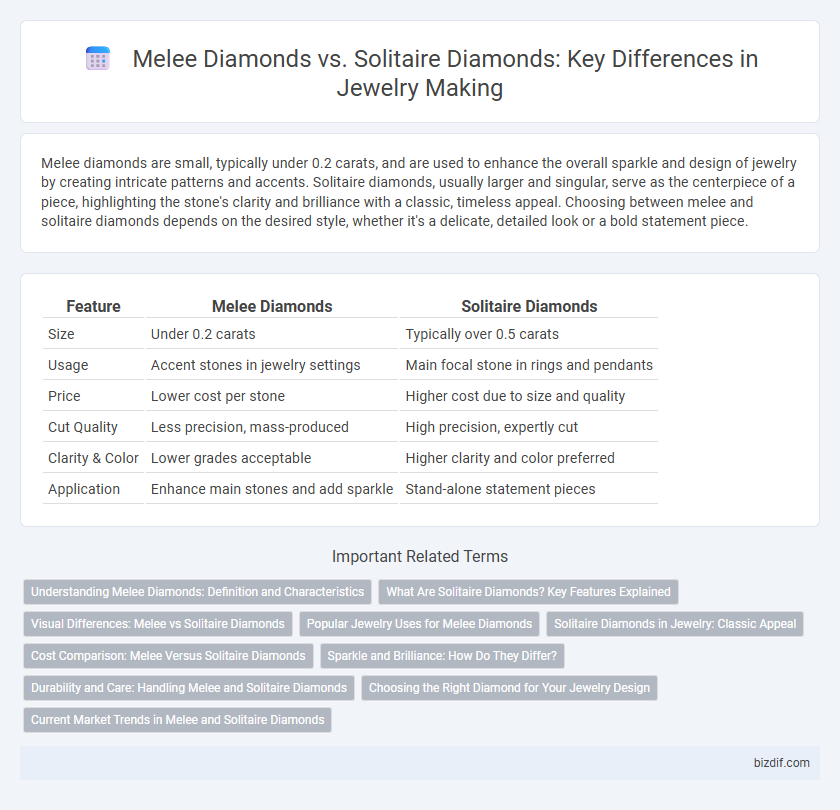Melee diamonds are small, typically under 0.2 carats, and are used to enhance the overall sparkle and design of jewelry by creating intricate patterns and accents. Solitaire diamonds, usually larger and singular, serve as the centerpiece of a piece, highlighting the stone's clarity and brilliance with a classic, timeless appeal. Choosing between melee and solitaire diamonds depends on the desired style, whether it's a delicate, detailed look or a bold statement piece.
Table of Comparison
| Feature | Melee Diamonds | Solitaire Diamonds |
|---|---|---|
| Size | Under 0.2 carats | Typically over 0.5 carats |
| Usage | Accent stones in jewelry settings | Main focal stone in rings and pendants |
| Price | Lower cost per stone | Higher cost due to size and quality |
| Cut Quality | Less precision, mass-produced | High precision, expertly cut |
| Clarity & Color | Lower grades acceptable | Higher clarity and color preferred |
| Application | Enhance main stones and add sparkle | Stand-alone statement pieces |
Understanding Melee Diamonds: Definition and Characteristics
Melee diamonds are small, typically less than 0.2 carats, used to enhance the sparkle and design of jewelry pieces without dominating the centerpiece. These diamonds are prized for their brilliance, uniformity, and precise cuts, making them ideal for pave settings and accent stones. Understanding melee diamonds involves recognizing their role in complementing solitaire diamonds by adding intricate detail and maximizing overall visual impact.
What Are Solitaire Diamonds? Key Features Explained
Solitaire diamonds are single, large diamonds prominently featured in jewelry designs, often symbolizing elegance and a focal point of a piece, especially in engagement rings. Key features include high clarity, exceptional cut quality, and a significant carat weight that showcases the diamond's brilliance and fire. Unlike melee diamonds, which are small accent stones used to enhance designs, solitaire diamonds are valued for their individual size and impact.
Visual Differences: Melee vs Solitaire Diamonds
Melee diamonds are small, typically under 0.2 carats, and are used to accentuate larger stones, creating a shimmering, textured surface in jewelry. Solitaire diamonds are larger, usually over 0.5 carats, serving as the central focal point with a bold and striking visual impact. The visual difference lies in melee diamonds' delicate sparkle versus solitaire diamonds' prominent brilliance and size.
Popular Jewelry Uses for Melee Diamonds
Melee diamonds, typically under 0.2 carats, are widely used in pave settings, halo designs, and intricate jewelry pieces to add sparkle and enhance the visual impact without overshadowing the centerpiece. These small diamonds are favored for accentuating solitaire diamonds by surrounding them with a shimmering frame and increasing overall brilliance in rings, bracelets, and earrings. Melee diamonds offer affordability and versatility, making them popular for customizing fine jewelry and creating detailed, luxurious designs.
Solitaire Diamonds in Jewelry: Classic Appeal
Solitaire diamonds hold classic appeal in jewelry due to their singular, prominent gemstone that symbolizes elegance and timeless beauty. These diamonds typically range from 0.50 carats to several carats, showcasing brilliance and clarity that captivate attention. Jewelry designs featuring solitaire diamonds highlight the stone's fire and sparkle, making them a popular choice for engagement rings and statement pieces.
Cost Comparison: Melee Versus Solitaire Diamonds
Melee diamonds, typically under 0.2 carats, offer a cost-effective option for adding sparkle to jewelry without a high price tag, whereas solitaire diamonds, often over 1 carat, command significantly higher prices due to their size and quality. The price per carat for melees is considerably lower, making them ideal for budget-conscious buyers or designs featuring multiple stones. Solitaires require greater financial investment but deliver a singular, prominent focal point with higher clarity and color grades.
Sparkle and Brilliance: How Do They Differ?
Melee diamonds, typically under 0.18 carats, offer a clustered sparkle that enhances the overall brilliance of jewelry by reflecting light from multiple small surfaces simultaneously. Solitaire diamonds, often larger than one carat, provide a focused brilliance with intense sparkle due to their size and precise cutting, maximizing light return through the crown and pavilion facets. The difference in sparkle intensity and light dispersion between melee and solitaire diamonds largely depends on their size, cut quality, and placement within the jewelry design.
Durability and Care: Handling Melee and Solitaire Diamonds
Melee diamonds, being smaller and often used as accent stones, require careful handling to prevent loss or damage, as their tiny size makes them more susceptible to wear and tear. Solitaire diamonds, typically larger and set as a centerpiece, demand regular inspections and professional cleaning to maintain their brilliance and structural integrity. Both types benefit from storing jewelry properly and avoiding harsh chemicals or rough activities to preserve their durability over time.
Choosing the Right Diamond for Your Jewelry Design
Melee diamonds are small, typically under 0.2 carats, ideal for accentuating intricate jewelry designs with sparkle and texture, while solitaire diamonds, usually larger than 0.5 carats, serve as the focal point in classic and minimalist pieces. Selecting between melee and solitaire diamonds depends on the desired visual impact, jewelry style, and budget considerations. Opting for melee diamonds enhances detail and brilliance in complex settings, whereas a solitaire diamond provides a bold, elegant statement.
Current Market Trends in Melee and Solitaire Diamonds
Current market trends reveal a rising demand for melee diamonds primarily in luxury jewelry pieces that emphasize intricate designs and affordability, driven by consumer preference for customization and ethical sourcing. Solitaire diamonds maintain strong appeal due to their timeless elegance and status as a symbol of commitment, with rising interest in lab-grown options enhancing their market share. Pricing dynamics indicate melee diamonds benefit from economies of scale, while solitaires command premium prices influenced by cut quality, carat size, and certification standards.
Melee diamonds vs solitaire diamonds Infographic

 bizdif.com
bizdif.com